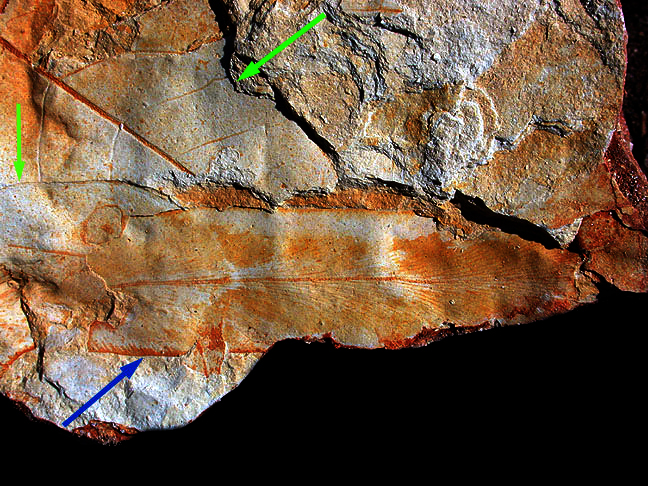
|
Here's a slab of feldspar-rich shale from the Middle Eocene Ione Formation that has a story to tell--three fossil leaves along the same bedding plane overlap one-another without intervening sediments; this suggests quite strongly that all three leaves accumulated at the same instant in geologic time, probably during an episode of flooding along the semi-tropical floodplain of sedimentary deposition. The green arrow tilted diagonally at upper middle points to an undescribed fossil leaf that first came to rest along the now-exposed bedding plane; next came the leaf fragment at lower left, also undescribed, marked by the green arrow whose tip points vertically, downward, to the leaf margin. And finally, last to come to rest along that ancient floodplain some 45 million years ago, was a nice fragment of a climbing fern, called Lygodium kaulfussi--marked by the blue arrow at lower left--all from the Middle Eocene Ione Formation, western foothills of the Sierra Nevada, California; reddish coloration is caused by iron oxide residues in the rocks. Note the well-preserved, characteristic parallel venation of the climbing fern specimen. Lygodium kaulfussi is most closely related to the living climbing fern, Lygodium palmatum, which is the only species of the genus Lygodium native to North America--it has been recorded from Mississippi, Alabama, and Georgia north through New England. The roughly 45 million-year-old specimen came from a n extraordinarily rich locality on private property in Amador County--a specific site currently under formal paleobotanical study by Dr. Jack A. Wolfe (retired member of the United States Geological Survey) and Howard E. Schorn (retired Collections Manager of Fossil Plants at the University California Museum of Paleontology in Berkeley), among others, who hope to use the fossils to help approximate the paleoelevation of the ancestral Sierra Nevada region during the geologic past. Along with the Eocene Clarno Formation of Oregon, this specific fossil site yields the only known common to abundant Lygodium climbing fern fossils west of the Rocky Mountains region of the United States. Scattered, rare occurrences have been reported from a select few localities in California, but only those Lygodium specimens collected from the site under study in Amador County have found their way to a museum. Hence, the Lygodium fossils from the Amador County locality are the only known fossils of climbing fern, collected in California, presently residing in a museum. Please note: All fossil localities in the Ione Formation of Amador County, California, presently occur on private property; explicit permission from the land owners must be secured before collecting fossils there. |